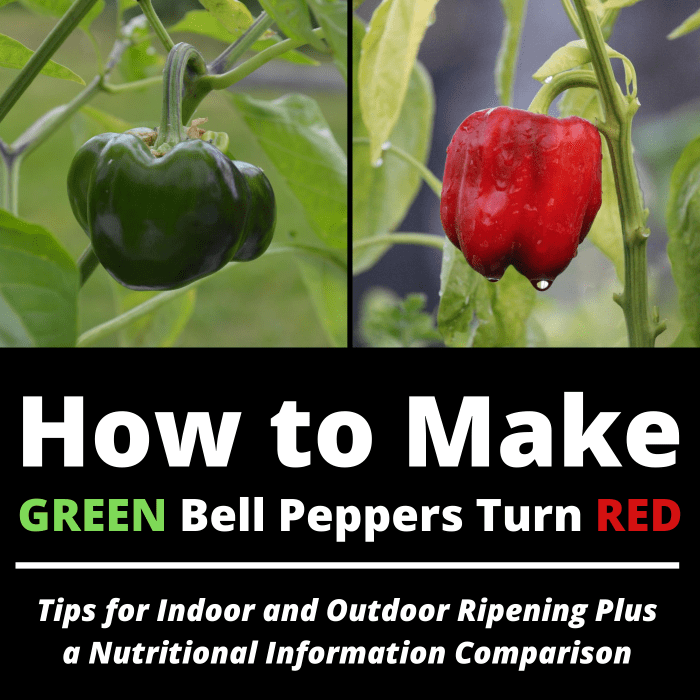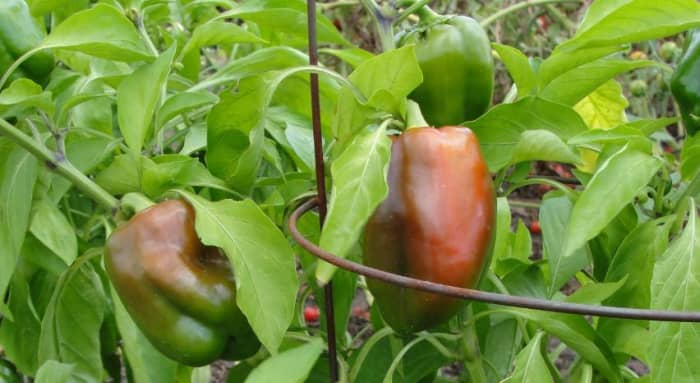Do Bell Peppers Continue to Ripen After Picking
I'm a gardener and nature-lover that enjoys giving tips on how to get the perfect red pepper.

Want those green peppers to ripen to red? Learn how long it takes and what you can do to help.
PxFuel; Tammy Sue via NeedPix; Canva
When we go to the grocery store, we can easily tell the difference between the green peppers and the red peppers. The color is usually either fully green or fully red, and the bells are priced accordingly. It is typical for red peppers to be quite a bit more expensive than green ones. In this article, we will cover the following:
- Do green bell peppers turn red?
- When should you pick your peppers?
- What are the differences between green and red peppers?
- How should you ripen red peppers indoors (off the vine)?
- How should you ripen red peppers outdoors (on the vine)?
1. Do Green Peppers Turn Red?
Red peppers are more expensive because they take longer to grow. Red peppers are simply mature green peppers, so producers can turn around green peppers in less time than red ones, and the price reflects that.
Before you worry too much about how to get a green bell pepper to turn red, you need to know that the red color is simply a sign that the pepper has reached its full maturity.
In fact, nearly all peppers will end up red if they are allowed to remain on the plant long enough. The trick to harvesting large, delicious red bell peppers is to use the varieties that turn red most reliably and then wait until that happens.
2. When Should You Pick Your Peppers?
Most red bell peppers will take 65–75 days to reach full maturity given proper growing conditions. If you want rich, red peppers, you must be prepared to wait out the lengthy maturation process. More specific tips and guidelines for ripening red peppers are provided in the sections below for both indoor and outdoor ripening scenarios.

These peppers are not crowded and are turning nicely from green to red.
landocheese
3. What Are the Differences Between Green and Red Peppers?
What is the big difference between green and red peppers? In fact, there are several major differences between green and red bells.
Taste
For one thing, red peppers are sweeter than green peppers. As the fruit matures, the taste changes from slightly bitter in the green stage to slightly sweet in the yellow or orange stage (if one exists) to very sweet in the mature red stage. Because of this, many people really enjoy the taste of the red fruits even if they don't care for the green ones.
Appearance
What really entices many shoppers is that red peppers look better in healthy dishes and homemade recipes since the bright red color is pretty and adds interest. This also increases their demand.
Nutrition
Another major difference is that red peppers are healthier than green ones if you look at the nutritional content:
- As the fruit turns from green to red, vitamin C content doubles, vitamin A content becomes eight times higher, and beta carotene nearly triples!
- Red peppers are a very good source of lycopene and are chock full of healthy antioxidants.
This doesn't mean that green peppers are not good for you—red peppers are just better.
| Nutrient | Red vs. Green |
|---|---|
| Vitamin A | 8 times higher |
| Vitamin C | 2 times higher |
| Beta Carotene | 3 times higher |
Scroll to Continue
Read More From Dengarden

Bell peppers start green and ripen to their final color. This tasty black pepper still retains its green core.
landocheese
4. How to Ripen Bell Peppers Off the Vine Indoors
Most people have heard that tomatoes will continue to ripen off the vine, but what about peppers? Will they also turn from green to red after they are picked?
This is an important question for gardeners, especially when the season is coming to an end and there are still several peppers in the garden that have not turned color.
The answer is . . . maybe.
It's true that a green pepper that is far enough along will continue to ripen indoors. To make this happen, keep the fruit on the counter or somewhere that is room temperature. Once it goes into the refrigerator, the ripening process will end. The best chance of success will come from bells that were just starting to change or that were about to. Immature green bell peppers may not make it to red in this manner.
Just leave the pepper out until it reaches the desired color or starts to look unhappy and like it wants to be refrigerated. You might very well get some more perfect red peppers this way, but peppers ripened off the plant will not be quite as sweet as those ripened outdoors in the sun, so there is definitely a trade-off.
5. How to Ripen Bell Peppers on the Vine Outdoors
One thing that works with all fruiting plants is to allow the plant to focus on doing fewer things at a time so that it can achieve the final goal of setting big, ripe fruit. This is also true of peppers.
A plant that is loaded with green peppers is using a lot more energy to grow all of them at the same time. This could result in far fewer pure red fruits eventually appearing on the plant. If this is the case in your garden, consider enjoying some of the peppers in their green stage. Be sure to snip them cleanly from the plant. This will allow the plant to use more energy on the remaining fruits, and they will turn color faster.
Some gardeners will remove a few leaves from a plant with lots of foliage to allow more sun to hit the plant. This may help, but the chance of the scalding sun or disease infecting the plant doesn't exactly seem worth it.
Instead, make sure the plants are spaced properly in the first place so that light can get to them. Planting peppers too close together can negatively impact the harvest.
One thing that does help with peppers is to keep the area humid. There are two great ways to do this:
- mulch to retain moisture in the soil, and
- underplant the area with some low-growing plant that will catch morning dew and raise humidity throughout the day.
I personally grow wave petunias throughout my pepper bed, and the plants seem to really like it. The sun does not hit the soil, and the area seems more moist and tropical.
Happy Growing!
Now you have a few tips to help you see some more red peppers this year.
Remember:
- Keep the humidity up.
- Don't let the plants be overcome with fruit.
- Give them enough space, and wait for nature to do its thing.
- If autumn is cutting the season short, go ahead and bring some green bells indoors to ripen in a warm place.
By doing these things, you can maximize the number of peppers that turn from green to red in your garden.
This content is accurate and true to the best of the author's knowledge and is not meant to substitute for formal and individualized advice from a qualified professional.
Questions & Answers
Question: What is a good pH level for bell peppers?
Answer: Bell peppers do best when the pH is in the sweet spot of 6.0 to 6.5.
daisy on August 22, 2020:
I am very happy to see that
nutritions in a mature red peppers are higher than a green one, especially the datum of vitamin A is eight times higher.
Thank you for sharing such lovely information.
Penny on October 07, 2017:
we planted green pepper plants but we are getting both red and green peppers off the vine, why is this?
Source: https://dengarden.com/gardening/How-to-Get-a-Green-Bell-Pepper-to-Turn-Red
Post a Comment for "Do Bell Peppers Continue to Ripen After Picking"